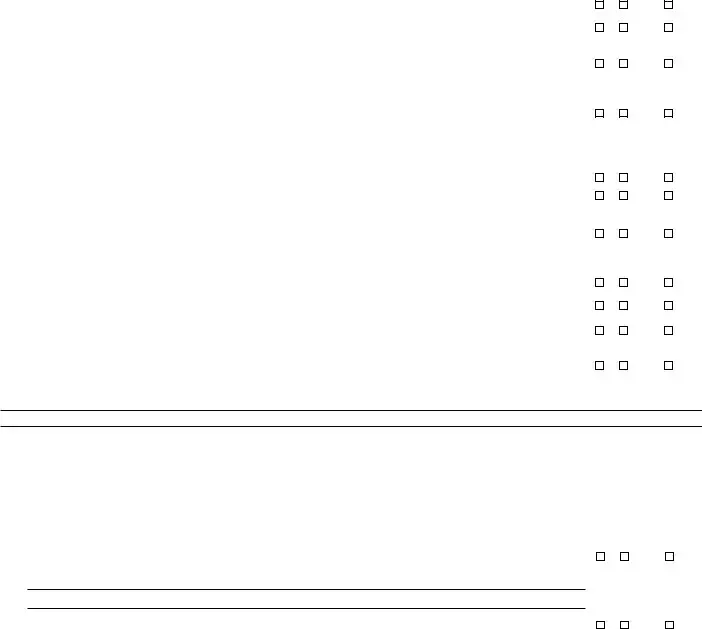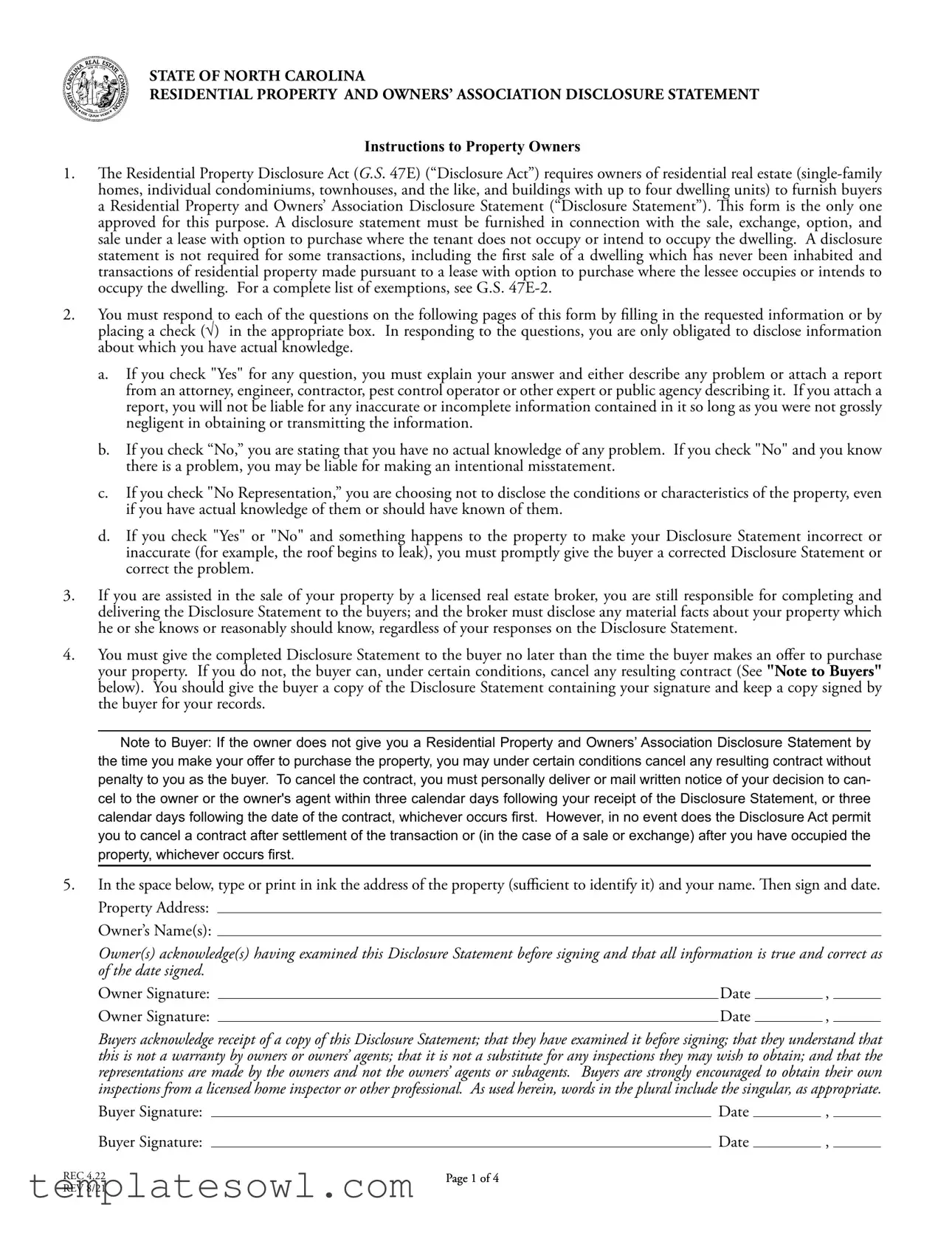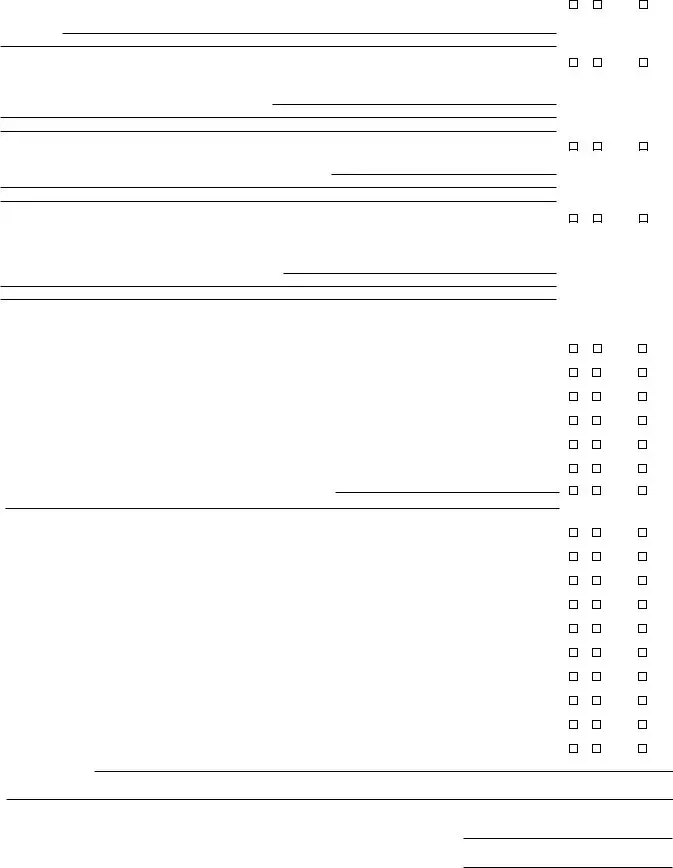STATE OF NORTH CAROLINA
RESIDENTIAL PROPERTY AND OWNERS’ ASSOCIATION DISCLOSURE STATEMENT
Instructions to Property Owners
1.The Residential Property Disclosure Act (G.S. 47E) (“Disclosure Act”) requires owners of residential real estate (single-family homes, individual condominiums, townhouses, and the like, and buildings with up to four dwelling units) to furnish buyers
aResidential Property and Owners’ Association Disclosure Statement (“Disclosure Statement”). This form is the only one approved for this purpose. A disclosure statement must be furnished in connection with the sale, exchange, option, and sale under a lease with option to purchase where the tenant does not occupy or intend to occupy the dwelling. A disclosure statement is not required for some transactions, including the first sale of a dwelling which has never been inhabited and transactions of residential property made pursuant to a lease with option to purchase where the lessee occupies or intends to occupy the dwelling. For a complete list of exemptions, see G.S. 47E-2.
2.You must respond to each of the questions on the following pages of this form by filling in the requested information or by placing a check (√) in the appropriate box. In responding to the questions, you are only obligated to disclose information about which you have actual knowledge.
a.If you check "Yes" for any question, you must explain your answer and either describe any problem or attach a report from an attorney, engineer, contractor, pest control operator or other expert or public agency describing it. If you attach a report, you will not be liable for any inaccurate or incomplete information contained in it so long as you were not grossly negligent in obtaining or transmitting the information.
b.If you check “No,” you are stating that you have no actual knowledge of any problem. If you check "No" and you know there is a problem, you may be liable for making an intentional misstatement.
c.If you check "No Representation,” you are choosing not to disclose the conditions or characteristics of the property, even if you have actual knowledge of them or should have known of them.
d.If you check "Yes" or "No" and something happens to the property to make your Disclosure Statement incorrect or inaccurate (for example, the roof begins to leak), you must promptly give the buyer a corrected Disclosure Statement or correct the problem.
3.If you are assisted in the sale of your property by a licensed real estate broker, you are still responsible for completing and delivering the Disclosure Statement to the buyers; and the broker must disclose any material facts about your property which he or she knows or reasonably should know, regardless of your responses on the Disclosure Statement.
4.You must give the completed Disclosure Statement to the buyer no later than the time the buyer makes an offer to purchase your property. If you do not, the buyer can, under certain conditions, cancel any resulting contract (See "Note to Buyers" below). You should give the buyer a copy of the Disclosure Statement containing your signature and keep a copy signed by the buyer for your records.
Note to Buyer: If the owner does not give you a Residential Property and Owners’ Association Disclosure Statement by the time you make your offer to purchase the property, you may under certain conditions cancel any resulting contract without penalty to you as the buyer. To cancel the contract, you must personally deliver or mail written notice of your decision to can- cel to the owner or the owner's agent within three calendar days following your receipt of the Disclosure Statement, or three calendar days following the date of the contract, whichever occurs first. However, in no event does the Disclosure Act permit you to cancel a contract after settlement of the transaction or (in the case of a sale or exchange) after you have occupied the property, whichever occurs first.
5.In the space below, type or print in ink the address of the property (sufficient to identify it) and your name. Then sign and date. Property Address:
Owner’s Name(s):
Owner(s) acknowledge(s) having examined this Disclosure Statement before signing and that all information is true and correct as of the date signed.
Owner Signature: |
|
Date |
|
, |
Owner Signature: |
|
Date |
|
, |
Buyers acknowledge receipt of a copy of this Disclosure Statement; that they have examined it before signing; that they understand that this is not a warranty by owners or owners’ agents; that it is not a substitute for any inspections they may wish to obtain; and that the representations are made by the owners and not the owners’ agents or subagents. Buyers are strongly encouraged to obtain their own inspections from a licensed home inspector or other professional. As used herein, words in the plural include the singular, as appropriate.
Buyer Signature: |
|
Date |
|
, |
Buyer Signature: |
|
Date |
|
, |
REC 4.22 |
Page 1 of 4 |
|
|
REV 8/21 |
|
|
|
|
Property Address/Description:
The following questions address the characteristics and condition of the property identified above about which the owner has actual knowledge. Where the question refers to “dwelling,” it is intended to refer to the dwelling unit, or units if more than one, to be conveyed with the property. The term “dwelling unit” refers to any structure intended for human habitation.
No
Yes No Representation
1. In what year was the dwelling constructed? |
|
. |
Explain if necessary: |
|
|
|
2.Is there any problem, malfunction or defect with the dwelling’s foundation, slab, fireplaces/chimneys, floors, windows (including storm windows and screens), doors, ceilings, interior and exterior walls, attached garage,
|
patio, deck or other structural components including any modifications to them? |
|
3. |
The dwelling’s exterior walls are made of what type |
of material? Brick Veneer |
Wood |
Stone |
|
Vinyl Synthetic Stucco Composition/Hardboard |
Concrete Fiber Cement Aluminum |
Asbestos |
|
Other |
|
|
|
|
|
(Check all that apply) |
4. |
In what year was the dwelling’s roof covering installed? |
|
|
(Approximate if no records are |
|
available) Explain if necessary: |
|
|
|
|
|
|
5. |
Is there any leakage or other problem with the dwelling’s roof? |
|
6. Is there any water seepage, leakage, dampness or standing water in the dwelling’s basement, crawl space, or slab?
7.Is there any problem, malfunction or defect with the dwelling’s electrical system (outlets, wiring, panel,
switches, fixtures, generator, etc.)?..................................................................................................................
8. Is there any problem, malfunction or defect with the dwelling’s plumbing system (pipes, fixtures, water heater, etc.)?
9. Is there any problem, malfunction or defect with the dwelling’s heating and/or air conditioning?...................
10. What is the dwelling’s heat source?  Furnace
Furnace 
 Heat Pump
Heat Pump 
 Baseboard
Baseboard  Other (Check all that apply) Age of system:
Other (Check all that apply) Age of system:
11. What is the dwelling’s cooling source?  Central Forced Air
Central Forced Air  Wall/Window Unit(s)
Wall/Window Unit(s) 
 Other (Check all that apply) Age of system:
Other (Check all that apply) Age of system:
12.What are the dwelling’s fuel sources? 
 Electricity
Electricity 
 Natural Gas
Natural Gas 
 Propane
Propane 
 Oil
Oil 
 Other (Check all that apply)
Other (Check all that apply)
If the fuel source is stored in a tank, identify whether the tank is 
 above ground or
above ground or 
 below ground, and whether the tank is
below ground, and whether the tank is 
 leased by seller or
leased by seller or 
 owned by seller. (Check all that apply)
owned by seller. (Check all that apply)
|
|
|
|
|
|
|
|
|
|
|
|
13. |
What is the dwelling’s water supply source? City/County |
Community System |
Private Well Shared |
|
Well |
Other |
|
|
|
(Check all that apply) |
|
14. |
The dwelling’s water pipes are made of what type of material? |
Copper Galvanized |
Plastic |
Polybutylene |
|
Other |
|
|
(Check all that apply) |
........................................................................ |
|
15. |
Is there any problem, malfunction or defect with the dwelling’s water supply (including water quality, quantity, |
|
or water pressure)? |
|
|
|
|
|
|
16. |
What is the dwelling’s sewage disposal system? |
Septic Tank Septic Tank with Pump |
Community |
|
System |
|
Connected to City/County System |
City/County System available Straight pipe (wastewater |
|
does not go into a septic or other sewer system [note: use of this type of system violates state law]) |
|
Other |
|
(Check all that apply) |
|
|
|
|
|
|
17.If the dwelling is serviced by a septic system, do you know how many bedrooms are allowed by the septic system permit?
If your answer is “yes,” how many bedrooms are allowed? 

 No records available
No records available
18. Is there any problem, malfunction or defect with the dwelling’s sewer and/or septic system?...........................
19.Is there any problem, malfunction or defect with the dwelling’s central vacuum, pool, hot tub, spa, attic fan, exhaust fan, ceiling fans, sump pump, irrigation system, TV cable wiring or satellite dish, garage door openers,
gas logs, or other systems?...............................................................................................................................
20. Is there any problem, malfunction or defect with any appliances that may be included in the conveyance
(range/oven, attached microwave, hood/fan, dishwasher, disposal, etc.)?..........................................................
Buyer Initials and Date |
|
Owner Initials and Date |
Buyer Initials and Date |
|
Owner Initials and Date |
REC 4.22 |
Page 2 of 4 |
REV 8/21 |
|
|

No
Yes No Representation
21. Is there any problem with present infestation of the dwelling, or damage from past infestation of wood
destroying insects or organisms which has not been repaired?..........................................................................
22. Is there any problem, malfunction or defect with the drainage, grading or soil stability of the property?..........
23. Are there any structural additions or other structural or mechanical changes to the dwelling(s) to be conveyed
with the property?...........................................................................................................................................
24.Is the property to be conveyed in violation of any local zoning ordinances, restrictive covenants, or other land- use restrictions, or building codes (including the failure to obtain proper permits for room additions or other
changes/improvements)?.................................................................................................................................
25.Are there any hazardous or toxic substances, materials, or products (such as asbestos, formaldehyde, radon gas, methane gas, lead-based paint) which exceed government safety standards, any debris (whether buried or covered) or underground storage tanks, or any environmentally hazardous conditions (such as contaminated
soil or water, or other environmental contamination) located on or which otherwise affect the property?.........
26. Is there any noise, odor, smoke, etc. from commercial, industrial, or military sources which affects the property?
27. Is the property subject to any utility or other easements, shared driveways, party walls or encroachments from
or on adjacent property?..................................................................................................................................
28.Is the property the subject of any lawsuits, foreclosures, bankruptcy, leases or rental agreements, judgments, tax liens, proposed assessments, mechanics' liens, materialmens' liens, or notices from any governmental agency that
could affect title to the property?...........................................................................................................................
29. Is the property subject to a flood hazard or is the property located in a federally-designated flood hazard area?
30. Does the property abut or adjoin any private road(s) or street(s)?....................................................................
31. If there is a private road or street adjoining the property, is there in existence any owners’ association or maintenance
agreements dealing with the maintenance of the road or street?..................................................................................
If you answered “yes” to any of the questions listed above (1-31) please explain (attach additional sheets if necessary):
In lieu of providing a written explanation, you may attach a written report to this Disclosure Statement by a public agency, or by an attorney, engineer, land surveyor, geologist, pest control operator, contractor, home inspector, or other expert, dealing with matters within the scope of that public agency’s functions or the expert’s license or expertise.
The following questions pertain to the property identified above, including the lot to be conveyed and any dwelling unit(s), sheds, detached garages, or other buildings located thereon.
32.Is the property subject to governing documents which impose various mandatory covenants, conditions, and restrictions upon the lot or unit?.....................................................................................................................
If you answered “yes” to the question above, please explain (attach additional sheets if necessary):
33.Is the property subject to regulation by one or more owners’ association(s) including, but not limited to, obligations to pay regular assessments or dues and special assessments? If you answer is “yes,” please provide the information requested below as to each owners’ association to which the property is subject [insert N/A into any blank that does not apply]:
|
|
|
|
|
|
|
|
|
|
|
|
|
|
|
|
• (specify name) |
|
|
|
|
|
|
|
|
|
whose regular assessments |
(“dues”) |
are $ |
|
|
per |
|
|
. The |
name, address and telephone number of the president of the owners’ association or the |
|
|
|
association manager are |
|
|
|
|
|
|
|
|
|
|
|
|
|
|
|
|
|
|
|
|
|
|
|
|
|
|
|
|
|
• (specify name) |
|
|
|
|
|
|
|
|
|
whose regular assessments |
(“dues”) |
are $ |
|
|
per |
|
|
. The |
name, address and telephone number of the president of the owners’ association or the |
association manager are |
|
|
|
|
|
|
|
|
|
|
|
|
|
|
|
|
|
|
|
|
|
|
|
|
|
|
|
|
Buyer Initials and Date |
|
|
|
|
|
|
Owner Initials and Date |
|
|
|
Buyer Initials and Date |
|
|
|
|
|
|
Owner Initials and Date |
|
|
|
REC 4.22 |
Page 3 of 4 |
REV 8/21 |
|
No
Yes No Representation
No
Yes No Representation
*If you answered “Yes” to question 33 above, you must complete the remainder of this Disclosure Statement. If you answered “No” or “No Representation” to question 33 above, you do not need to answer the remaining questions on this Disclosure Statement. Skip to the bottom of the last page and initial and date the page.
34. Are any fees charged by the association or by the association’s management company in connection with the conveyance or transfer of the lot or property to a new owner? If your answer is “yes,” please state the amount of the fees:
35. As of the date this Disclosure Statement is signed, are there any dues, fees, or special assessments which have been duly approved as required by the applicable declaration or bylaws, and that are payable to an association to which the lot is subject? If your answer is “yes,” please state the nature and amount of the dues, fees, or special assessments to which the property is subject:
36. As of the date this Disclosure Statement is signed, are there any unsatisfied judgments against, or pending lawsuits involving the property or lot to be conveyed? If your answer is “yes,” please state the nature of each pending lawsuit, and the amount of each unsatisfied judgment:
37. As of the date this Disclosure Statement is signed, are there any unsatisfied judgments against, or pending lawsuits involving the planned community or the association to which the property and lot are subject, with the exception of any action filed by the association for the collection of delinquent assessments on lots other than the property and lot to be conveyed? If your answer is “yes,” please state the nature of each pending lawsuit, and the amount of each unsatisfied judgment:
38. Which of the following services and amenities are paid for by the owners’ association(s) identified above
out of the association’s regular assessments (“dues”)? (Check all that apply).
Management Fees..........................................................................................................................................
Exterior Building Maintenance of Property to be Conveyed..........................................................................
Master Insurance...........................................................................................................................................
Exterior Yard/Landscaping Maintenance of Lot to be Conveyed....................................................................
Common Areas Maintenance........................................................................................................................
Trash Removal...............................................................................................................................................
Recreational Amenity Maintenance (specify amenities covered)
Pest Treatment/Extermination.......................................................................................................................
Street Lights..................................................................................................................................................
Water.............................................................................................................................................................
Sewer............................................................................................................................................................
Storm water Management/Drainage/Ponds...................................................................................................
Internet Service.............................................................................................................................................
Cable.............................................................................................................................................................
Private Road Maintenance.............................................................................................................................
Parking Area Maintenance.............................................................................................................................
Gate and/or Security......................................................................................................................................
Other: (specify)
Buyer Initials and Date |
|
Owner Initials and Date |
Buyer Initials and Date |
|
Owner Initials and Date |
REC 4.22 |
Page 4 of 4 |
REV 8/21 |
|



 Furnace
Furnace 
 Heat Pump
Heat Pump 
 Baseboard
Baseboard  Other (Check all that apply) Age of system:
Other (Check all that apply) Age of system: Central Forced Air
Central Forced Air  Wall/Window Unit(s)
Wall/Window Unit(s) 
 Other (Check all that apply) Age of system:
Other (Check all that apply) Age of system:
 Electricity
Electricity 
 Natural Gas
Natural Gas 
 Propane
Propane 
 Oil
Oil 
 Other (Check all that apply)
Other (Check all that apply)
 above ground or
above ground or 
 below ground, and whether the tank is
below ground, and whether the tank is 
 leased by seller or
leased by seller or 
 owned by seller. (Check all that apply)
owned by seller. (Check all that apply)

 No records available
No records available
